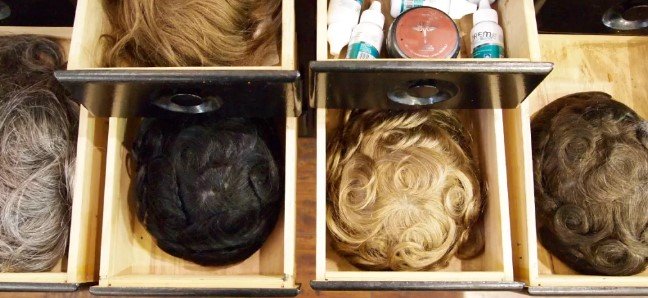Non-Surgical Hair Replacement Systems
THE HISTORY OF NON-SURGICAL HAIR REPLACEMENT SYSTEMS
Modern Hair Replacement Systems For Men at Cochrane & Co in London

Societal prejudice against individuals who experience hair loss at an early age is long-standing and cross-cultural. Somewhere between 1 BC and AD 1, the Roman poet Ovid wrote “Ugly are hornless bulls, a field without grass is an eyesore, So is a tree without leaves, so is a head without hair.”
In the stories of ‘The Arabian Nights’ written around AD 800-900, Scheherazade asked “Is there anything more ugly in the world than a man beardless and bald as an artichoke?”
Given such strength of feeling, it’s no surprise that the use of lotions, potions and snake oils, designed to prevent or cure baldness have been common throughout history. The remedies were varied, often gruesome and the one thing they had in common was that none of them worked!
A medical text dating back to 1550 BC shows that the Egyptians favoured a mixture of fats from a hippopotamus, crocodile, tomcat, snake and ibex, or alternatively, porcupine hair boiled in water and applied to the scalp. Hippocrates, regarded as the father of Western medicine, prescribed a mixture of opium, horseradish, pigeon droppings, beetroot and spices. Julius Caesar favoured a remedy suggested by Cleopatra consisting of ground-up mice, horse teeth and bear grease.
In the 19th century, cold Indian tea and hunks of lemon were in fashion. This was probably rather sweeter smelling than some of the earlier alternatives and certainly less threatening to the local wildlife, but equally ineffective.
How To Slow Down Hair Loss
There are, finally, two medical treatments which can prevent or slow down some kinds of hair loss, Minoxidil applied topically is effective in some cases of male pattern baldness and alopecia areata but ineffective against other kinds of hair loss.
Finasteride can also used to treat male pattern baldness, though the 2% risk of side effects including decreased sex drive and erectile or ejaculatory dysfunction limits the appeal of the latter for many people.
Wigs and Toupees

The earliest known example of a toupee (used to cover part of the scalp, as opposed to a wig, used to cover the whole head) dates back to before 3000 BC and was found in a tomb near the ancient capital of Egypt, Hierakonpolis.
Julius Caeser is known to have worn one and two ancient Greek statues of men wearing toupees survive today.
The use of hairpieces has come in and out of fashion over time. King Louis XIII of France, wore a toupee to mask his balding scalp, prompting a revival of their popularity in seventeenth-century France.
Massive wigs, often featuring elaborate curls were adopted by French and English nobles and early American colonists followed the lead of their peers until the American Revolution made the imitation of European-inspired styles unfashionable.
Moving into the nineteenth and twentieth centuries the uses of toupees to mask baldness became fashionable once more.
In both the USA and later in the UK perceptions shifted to value the appearance of youth over maturity, baldness was seen as a sign of ageing and regarded as unattractive.
By the 1950s, it was estimated that over 350,000 of men in the USA wore toupees, by 1959 U.S. sales were estimated to total $15 million a year and by 1970, it’s thought that in the USA toupées were worn by more than 2.5 million men.
As so often, the Old World followed the New with regard to fashion and the use of toupees to conceal hair thinning or baldness and boost social confidence increased over time in the United Kingdom also.
Undoubtedly, part of the reason for the renewed popularity of the toupee lays in the increased quality of the hairpieces available.
This development was largely pioneered by Max Factor who led the way in creating almost pieces featuring real hair with each strand sown into a piece of fine flesh-coloured lace, A variety of styles and lengths were available the suit the needs of the individual.
The Decline Of The Toupee
Despite the improved quality of twentieth century toupees, their popularity waned.
Men wearing bad toupees were often the butt of bad jokes and horror stories of hairpieces being lost at socially embarrassing moments abounded.
An early example of “toupée humor” was an illustration in “The Comic Almanack” of 1837. In this sketch by George Cruikshank a strong wind was shown to remove a man’s toupee from his head.
Along with jokes about badly fitting wigs or toupees there’s also been a change in attitude towards hair loss.
From Yul Bryner through to Patrick Stewart, television and screen stars have demonstrated that bald can indeed be beautiful.
This is all well and good for those who are able to accept their hair loss, but while total baldness in men may sometimes be regarded as sexy, the process of pattern balding or gradual thinning is not generally seen as attractive.
Hair Transplants v Hair Replacement Systems
The main reason why toupee wearing is in the decline has less to do with changes in social attitude to baldness than to the fact that in the twenty-first century there are far better options for those seeking a discreet and robust solution to hair loss.
Hair transplants are an option for some. These however are surgical and thus invasive, they’re expensive, far beyond the reach of the average member of the public, and since they rely on the use of donor hair from another part of the head, they can only be used a limited number of times. Plus they don’t always work.
Modern, non-surgical hair replacement systems involve the application of a thin layer of artificial skin containing strong human hair to the bald or thinning areas of the scalp.
Once applied the hair can be cut and styled according to the specific requirements of the recipient.
Providing the hairpiece is correctly applied it will stay in place during all normal activities including sleep, showering, playing vigorous sports and even whilst swimming.
Properly applied by an appropriately skilled expert the replaced hair will stay in place for up to 13 weeks!
Choosing to embrace baldness may be an option for some, but it’s not for everyone and should a personal choice not an imposed attitude.
The good news for those seeking an alternative is that there are more affordable and discrete solutions available today than there have ever been.

